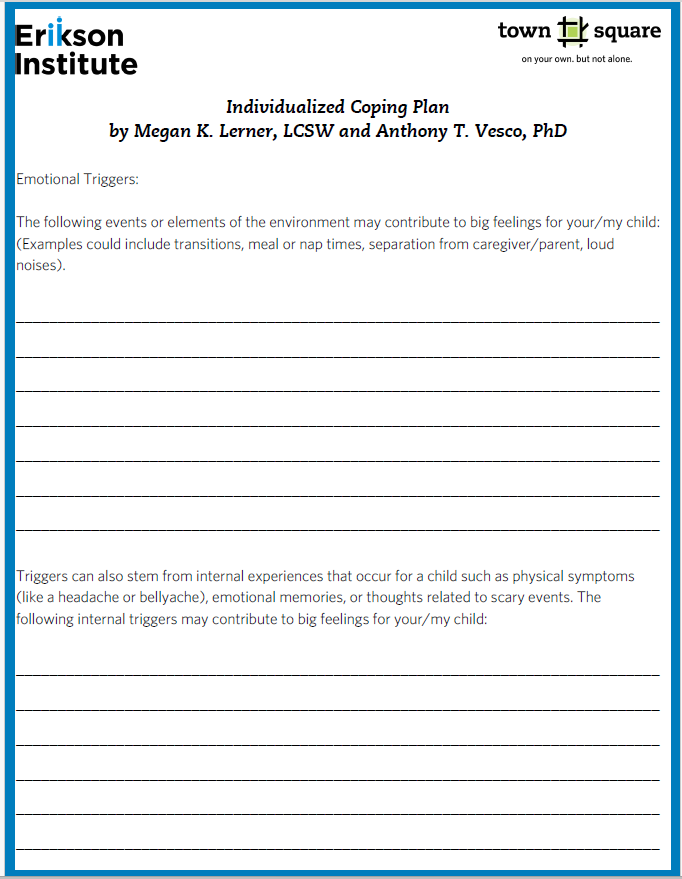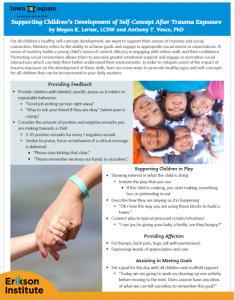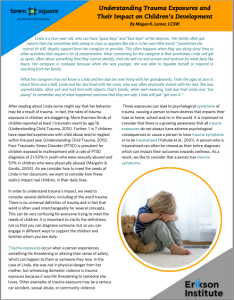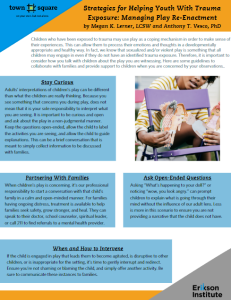This resource, from Megan K. Lerner, LCSW and Anthony T. Vesco, PhD, will help you work with families and children who are struggling with behavioral issues.
There are two versions of this resource, one to hand write and one to complete on the computer. 
One of the most perplexing things that can happen when a child’s inappropriate behavior is being addressed is laughter. We’re prepared for averted eyes or signs of shame, but why is laughter some children’s go-to?
Do they believe their actions are funny? Do they think the adult is being funny? Is it an act of rebellion or disrespect?
Actually, none of the above. Laughter is a stress response. While it’s a difficult perspective shift to make, seeing the laughter and interpreting it as crying is likely much closer to the child’s internal state than most people would assume.
Knowing this, what can we as providers change in response to a child’s laughter and perceived defiance? How can we make our own mental shift to handle this effectively, still teach the child the prosocial skills we are looking to impart, and not cause harm by becoming more intense and escalating the child’s sense of fear?
The first step is deescalating yourself to be ready to coregulate. This might be a mantra, counting backwards, or slow and purposeful breathing to remind yourself that the child is struggling.
Next is coregulation: helping the child to feel safe again. This can be hard if you’re still focused on the initial behavior. Rest assured, this doesn’t mean not addressing the initial incident. It does mean that the child will be emotionally prepared and ready to learn from it. Breathing with the child– one of my favorite methods is five-finger breathing, as shown in this video:
Once you’re both feeling calm, then it’s time to address the initial challenging behavior.
Questions for Reflection:
Have I seen children laugh or otherwise respond in an unexpected way to correction? What have I done before?
What might get in the way of taking the time to calm down myself and the child?
When else might it be useful to implement intentional calming strategies like finger breathing with children?
In the Paths to Quality Standards for Participation, there are 13 standards that family child care providers must meet to move from level 1 to level 2. One practice states:
Each child feels safe, accepted, and protected. This is supported by daily practices that reinforce respect for people, feelings, ideas, and materials.
What does it mean to feel safe, accepted, and protected? What are daily practices that support children in feeling this way? Paying attention to each child and taking advantage of time to connect, even though this is difficult in group care, is a great start. Especially during caregiving times like feeding and diapering/toileting when children are at their most vulnerable. In the RIE philosophy of infant caregiving, this is called “want something quality time.” When the adult has a goal, but it can be accomplished mutually with the child’s cooperation, and the time can be spent in a pleasant interaction with the child rather than rushed through.
This is in addition to “want nothing quality time,” when adults spend time playing with, talking to, and observing children without another agenda. Helping children feel safe also involves self-reflection. Knowing how to handle children’s challenging behaviors is an ongoing process and requires some self-reflection to ensure that adult responses are compassionate and appropriate and demonstrate to the child that the adult isn’t a threat. It’s easy to forget that adults are many times the size of a young child and can easily feel frightening to them. As Circle of Security says, the adult must choose to be “bigger, stronger, wiser, and kind.”
Respect for ideas is simply listening to children and helping them have discussions together in a way that allows for free expression of thoughts without ridicule.
Respect for materials might be more complicated. One of the greatest frustrations in family child care can be broken materials! But daily practices that can support respect for materials might include helping children choose the right materials for their chosen activity (throwing sponge balls instead of blocks), and teaching and modeling appropriate use of materials such as paintbrushes and markers.
Reflection:
- How can you tell when a child is feeling safe?
- What frequent occurrence is most likely to dysregulate you? Spilled paint? Children squealing? How can you proactively support your own wellness and calm?
Understanding Trauma Exposures and Their Impact on Children’s Development
This printable handout by Megan K Lerner, LCSW supports adults in understanding how children can be impacted by trauma.
What can a child learn from a fight? A lot, with the right opportunities.
A dispute with a peer can teach a child about how to voice their own needs, how to weigh the needs of another, and how to compromise and problem-solve with others.
In the Japanese practice of Mimamoru (literally, “watch and protect”), early childhood practitioners are trained to intervene minimally and later than many American early childhood educators would expect, while still closely observing children’s fights. The principle behind this is that while the adult’s role is to protect the children, children need the experience of navigating social complexity to build their social skills. A child who hits another and is then sent away from the activity learns that the adult nearby doesn’t want them to hit but does not learn how to get their needs met. When that same adult stop in, checks on the child who was hit, and helps both children verbalize their wants and needs, both children have the opportunity to understand each other and find a solution.
Perhaps the more difficult situation here is one where the attacks aren’t physical, but emotional. Relational aggression (e.g. “You’re not my friend!” or “You can’t come to my birthday party!”) can be more difficult to intervene in, and harder to spot. This also tends to peak in late preschool and early elementary years as children refine their definition of friendships and understand what it means to be a friend, as well as the power that comes from being included or excluding others.
In either act of aggression, how can the educator offer a learning opportunity instead of simply managing or shutting down the behavior? People are born with the desire to connect, and emotional resilience, as well as a guiding moral voice. What needs to be scaffolded are the skills to advocate for oneself and listen to and hypothesize about others’ perspectives.
First, look at the purpose of adult interventions: no one wants the children to be hurt, physically or emotionally. But in the same way that learning to walk comes with a few tumbles, learning to be a friend and participant in a community comes with its own missteps. If children cannot learn from each other and us when they’re small, they won’t have the experience to navigate social relationships as they become more complex.
This is the platform on which larger concepts of restorative justice are built; instead of punishing the person who harmed another, we work to ensure that the person who was hurt is comforted, and the person who did the hurting has the resources to avoid doing it again.
Questions for your reflection:
- What was your first reaction when you thought about waiting to intervene?
- What are your current intervention strategies when children are fighting?
- How could you integrate a “pause” before intervening?
- What else could you do to support children in learning conflict mediation?
When providers encounter children engaging in play with troubling themes, it’s important to understand how to interact with the children in their play, when and how to interrupt, and how to talk to families about our observations. This one-page downloadable/printable document from mental health professionals Megan Lerner, LCSW and Anthony T. Vesco, PhD, can help prepare you for these difficult situations.
Supporting Children’s Development of Self-Concept
This resource was developed with Megan K. Lerner, LCSW, and Anthony T. Vesco, PhD, as part of their series on trauma informed principles and practices in Family Child Care settings.
This webinar discusses how providers can work to support all children in becoming empathetic community members.
Consider: How do the principles of safety needs and growing needs influence how you plan your program? How can you prioritize building secure attachment with the children in your program?
This nine-part course (approximately 3 hours and 45 minutes) from the National Child Traumatic Stress Network will teach participants about “early childhood social-emotional development; the impact of stress and trauma; reflect on the possible meanings of children’s behaviors; explore the influence of culture on families’ socialization goals; and become familiar with a number of strategies aimed to promote secure attachment and safe socialization practices.”
Providers will need to sign up for a free account to access this resource.
Calming spaces in early childhood environments are widespread but creating them with intentionality and teaching children how to use them can be big tasks. When we see disruptive behavior as a sign of a dysregulated child, and provide the tools for that child to re-regulate, we are setting them up for lifelong success as they grow to become people with strong self-regulation and impulse control skills.
These two handouts provide opportunities for you to reflect on how adults use their sensory systems to self-regulate and how to use that information to create calming spaces to support children’s social-emotional development.


